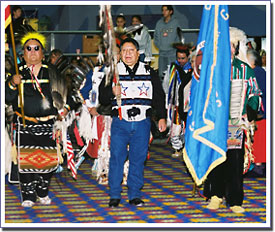
American movies help perpetuate European stereotypes
Strength of Native culture overpowers oppression
Changing 's-word' controversial but needed to make a difference
Director, UI School of Communication
Native culture rich, important stories to be told
UI Journalist in Residence, 2001 -02
Cooperation key to gathering information
| Shortly
after arriving at my new job at the University of Idaho in the summer
of 2000, I met Mark Trahant, who had served for several years as
a member of the UI School of Communication’s Advisory Board.
I knew of Mark because of his national reputation as a journalist
and as an activist for cultural diversity in America’s newsrooms.
|
I
had the privilege of working with ten upper-level University of Idaho
School of Communication journalism students this year to complete
a Native Journalism Project. The project is the result of a one-year grant to the UI School of Communication from the Freedom Forum, thanks to trustee Mark N. Trahant. It is patterned after a similar project the University of Montana School of Journalism has done for the last ten years. I learned right along with the students as we traveled from one end of the state to the other visiting all five Idaho Indian reservations. From the remoteness of the Duck Valley Reservation on the Idaho/Nevada border in southwestern Idaho to the Kootenai Reservation 30 miles from the Canadian border, the Native people were all gracious hosts and very willing to share information with us so we could learn more about their people and culture. The goal was to learn about covering tribal issues and sovereignty. What we learned is when covering Native issues, journalists need to learn about the respective tribe – its government, history, culture and issues. All tribes are different and all have different issues, but they also have similar concerns regarding land, protection of treaty rights, water, natural resources, culture and exercising sovereignty. Thank you to all of the tribal people, the students, the Freedom Forum and Mark Trahant, UI School of Communication Director Chris Campbell and to my husband Delson and children Hoss, Noah and Lucy, who allowed me to be away from them. 
|
||||||||
|
|||||||||